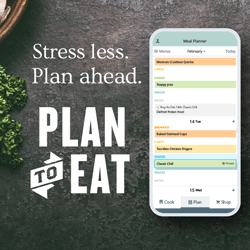With two days left to fulfill my Handmade Holidays promise, I’m totally geeking out about this pattern. In the interest of full disclosure, Alice the Fabric Ninja is a friend and our kids are besties. She provided her pattern to me gratis in exchange for my honest feedback. So, here goes:
How easy is it? I feel like this pattern is an excellent choice for advanced beginner sewists–a total beginner could survive it with very careful reading of the instructions and reliance on Alice’s great video tutorial, or with hands-on help in a sewing class setting. Advanced stitchers could practically make it up blindfolded. I read over the instructions a few days before starting, to provide Alice with some critique on the copy, and didn’t consult them at all while I was working.
How clear are the instructions? They read clearly and there are lots of photos. But, I am not the person you want judging this for you–I regularly throw the instructions that come in pattern envelopes in the recycle bin. My ideal pattern with all of its markings is intuitive enough that I don’t need to consult the manual.
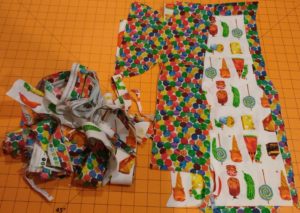
Here’s what was left of 2 yards each of fabric and lining. The pieces on the right may have been enough to cut another bag with side, bottom, and strap cut separately, but I only had 5 giftees to worry about.
How wasteful is it? Not at all. I had 7 bags to create for Christmas. I bought Very Hungry Caterpillar print fabric for five of them and cut 5 bags from 2 yards each of fabric and lining, with very minimal waste. Only one bag had to be pieced. The “cabbage” was wide enough to save for doll waistbands and other tiny projects, and the large leftover piece on the edge left enough to cut a pair of size 8 kid shoes with plenty to spare for more shoes or matching wallets, perhaps.
I paid an inordinate sum for the out-of-print Cars and Trucks and Things That Go–themed cotton, so low-waste was doubly-important there. Using the 3-piece bottom, side and strap option, I was able to cut carefully enough to get 1 adult and 1 kid bag with just barely enough left over to yield a pair of boxer shorts for my husband (Richard Scarry books are one of the inter-generational obsessions around here).
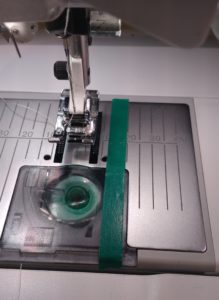
Tip: Save time by masking off the seam allowance with washi tape! I hate pinning and avoid it where possible (huge time suck). Marking the seam allowance on the stitch plate means fewer minutes transferring markings from pattern to fabric.
How fast is it? This pattern lends itself well to batching. I assembly-lined all of the bags through in record time. Cutting the fabric and applying interfacing was the most time-consuming part of the process. I rarely sew with pins–just 1-2 per item on this project where markings needed to be matched up, and most of the seams are straight. All told, I’d estimate these 7 bags took me 7 hours from cutting to dumping them into my hand-finishing basket (the only hand-stitching is seaming the hole in the lining from turning–I opted for Kam Snaps and tab closures because time is very precious right now).
What’s the catch? This pattern uses a lot of interfacing. Maybe this doesn’t bug other people, but interfacing is something I don’t keep on hand in large quantities. I hate how narrow it is–in this case, it’s barely wide enough for 1 bag and as a result, there’s a lot of waste. The potentially most fabric efficient variation (the strap/side/bottom section pieced together completely) results in so many more seams and sewing time. It’s a classic project management triangle problem–you can:
- lose quality but save money and time by skipping the interfacing,
- lose time but save money and increase quality (and subjective beauty) by piecing the bag and colorblocking it, or
- lose money cutting the side/bottom/strap on the fold with a resulting bag that is higher quality and much quicker to produce.
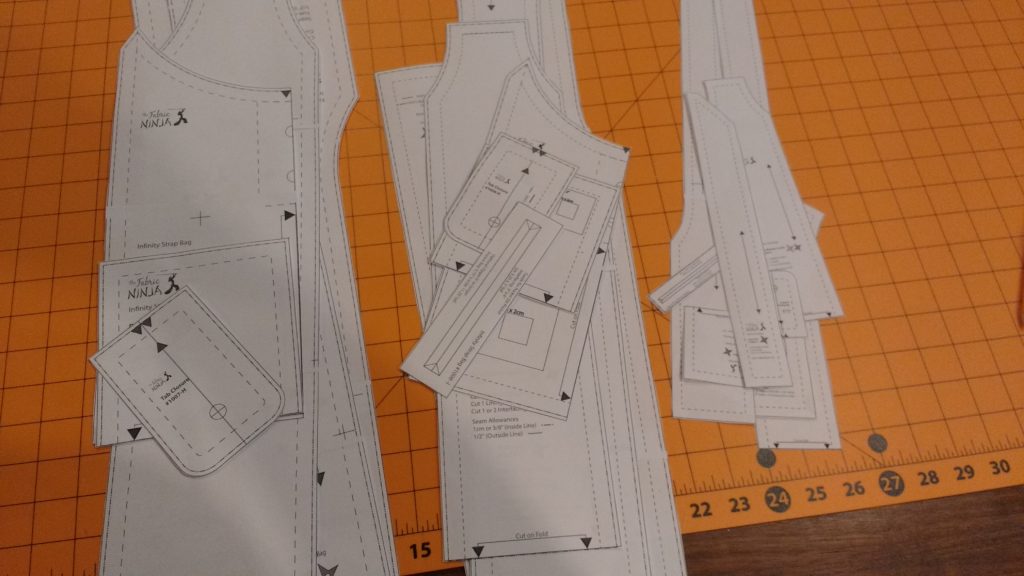
All the pattern pieces for the Adult medium, Child, and Doll sized bags. Markings are very clear, and seam allowances are included. Note the bonus pattern pieces – for piecing or colorblocking without having to DIY.
Other nifty features: The pattern includes lots of pattern pieces, which could be a bit overwhelming for a beginner, but it is very handy. While the obvious winner (in my time-obsessed opinion) is putting together a bag that has only 6 pieces (front, back, and the side/bottom/strap all cut in one continuous strip for the bag and the lining) and the fewest seams possible, Alice has included alternative pattern pieces with seam allowances already marked off so that you can cut the bottom, sides, and/or straps as separate pieces. I did this on a couple to make the best use out of fabric and prevent waste (just doing the bottom as a separate piece), but the possibilities for patchwork and colorblocking are endless. Sure, you could colorblock it yourself by altering the standard pattern, but who has time for all that measuring and adding of seam allowances? Speaking of time wasters: I loathe piecing together printable patterns, but this one was relatively painless. It matched up easily with clearly marked crosses. I use a glue stick to save time, just in case you’re curious.
Make your own! Here’s what I used:
Pattern: Infinity Tie Strap Tote pattern from The Fabric Ninja
Fabrics: Andover Fabrics Very Hungry Caterpillar Abstract Dots and Snacks; VIP Exclusive Busytown On the Move (out of print)
Notions: Size 20 Kam Snaps, Pellon P44F Fusible Interfacing, Gutermann Natural Cotton Thread
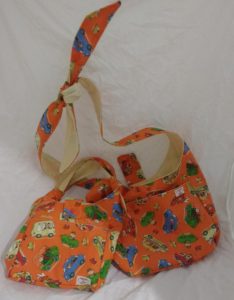
An homage to one of my husband’s favorite books as a kid, and one that he really enjoys reading to our girls, from his falling-apart childhood copy. Grandma/grandkid matched set (shh–don’t tell!).
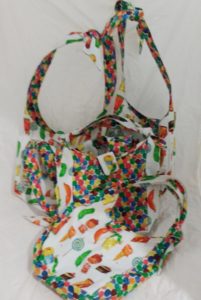
Five bags–it’s hard to tell where one begins and the other ends. Each one is a bit different–all of them are reversible, but some have a contrast side vs. front, others are all one fabric on the outside. Some have contrast tabs, others have tabs that match the side of the body they’re touching. Each snap is a different color.

